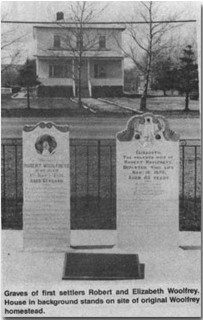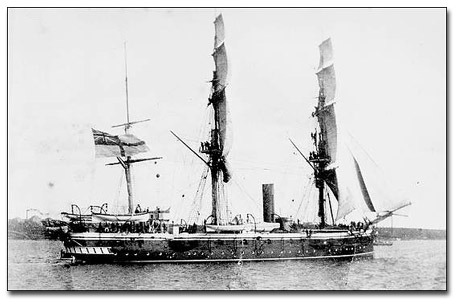| Sources differ in naming the first Woolfrey to settle at Lewisporte. Some say it was Robert, others say it was George, while others speak of the Woolfrey brothers. Herbert Woolfrey has written that his grandfather Robert and his sons were the first settlers but that Robert died the same year, the result of a fall on the deck of a schooner. This would have certainly left the Woolfrey brothers as the first settlers, one of whom was William George Woolfrey, Herbert’s father. Robert’s wife, Elizabeth, also died within a few years of arriving and was buried next to her husband. She had been a Sunday school superintendent at Moreton’s Harbour. The Woolfreys had a civilizing effect on the area, in the first year building a small schoolhouse that doubled as a place of worship and Sunday school. Maria Woolfrey was the first teacher.
The majority of early settlers were Wesleyans from predominantly Anglican communities, but whether they moved for religious or economic reasons cannot be said with certainty. There was much to attract settlement as Burnt Bay had abundant stands of trees down to the water’s edge and, once cleared, much arable land - two commodities that by this time were in increasingly short supply on the islands to the north. Senator Fred Rowe has written that his grandfather, an early settler: "occupied and received a grant for about 50 acres, a large area compared with the cramped circumstance of the outside islands."
During the summer, the early settlers built flakes and huts and continued with the summer fishery. The winter months were what Herbert Woolfrey described as a time for hard labor. Men took to the woods with axes and pit saws and as soon as they had enough lumber sawed, started building houses and boats. This abundance of timber and concentration on boatbuilding in the following decades gradually superseded the fishery as the mainstay of the community.
By 1884 the community had 25 families, all but seven of the 150 inhabitants being Wesleyans. The census makes no mention of a church or minister but the fledgling community was visited by missionary ministers, the first being Rev. Thomas Early from Herring Neck. It has also been suggested that the first church was built in 1880, the same year as the first school, but it seems probable they were the same building. There is no mention of a church in the 1891 census although a school with accommodations for 50 is listed. Unfortunately, records for this period are rare, most having perished in a 1905 blaze that destroyed the parsonage.
The community was called Big Burnt Bay in the 1891 census when 235 inhabitants were recorded. It was also for a time called Marshville or Marshallville after the Rev. Marshall who is also said to have given the name Woolfrey its present spelling. Prior to that it was Woolfray. In 1901, Lewisporte received its first permanent Wesleyan minister, the Rev. C. Abner Whitemarsh. He enlisted the aid of Isaac Dean and a Mr. Butler from Botwood to build a church on the site of the Loyal Orange Lodge the following year. Work started on a new Methodist church in 1913, completed and dedicated as St. Matthew’s in 1916.
Economic events around 1900 were to have a major and lasting effect on Lewisporte. One was the building of a branch railway line from Notre Dame Junction. This ultimately led to Lewisporte’s becoming a shipping, distribution, and supply centre for Labrador - and the northeast coast once the trans-insular railway was completed in 1898. The other major event was the building of a lumber yard at Lewisporte by Lewis Miller in 1900.
Scottish born Lewis Miller who had extensive lumber interest in Sweden, established himself in Newfoundland just prior to 1900. Sweden had refused to renew timber leases to foreign nationals and Miller, possibly influenced by fellow Scot Sir Robert G. Reid and stories of vast timber reserves and a convenient railway in Newfoundland, established lumber mills at Glenwood and Millertown. At Marshville he established a lumberyard to handle 40 million board feet of lumber a year. Sawmills at Glenwood, Notre Dame Junction, Norris arm, Grand Falls, Millertwon and Badger sent lumber to Marshville. Wharves were built, one some 900 ft. long, so that brigs, brigantines, barques could transport the lumber to foreign parts.
Lewis Miller had also brought with him 60-70 of his Swedish employees. Some formed a small community at the end of the railway track which together with the sidings and yards, they had helped build. Around 1900 the name of the town was changed to Lewisport (the final e was added later) in honor of Miller. The name of Millerport was briefly considered but discarded as being too easily confused with Millertown. Lewisporte became a boom town.
Miller had initially engaged his Swedish employees on a three-year contract at $1 a day, a figure that it was hoped could be improved upon in time. But the initial timber surveys had been optimistic and much of the wood was over-mature. Miller suffered other setbacks too: a new sawmill at Millertown burned down under mysterious circumstances. Miller’s business was not quite the economic success he had hoped. In 1903 his Swedes started to move away, some to Minnesota, others back to Sweden. Miller sold out and moved to Sheet Harbour, N.S. The buyer, Harry J. Crowe, later sold out to the Harmsworth family in England who later established the Anglo-Newfoundland Development (A.N.D.) Company mill in Grand Falls.
In the meantime, Lewisporte’s fortunes remained buoyant. From 1906 to 1908 construction of the A.N.D. pulpmill at Grand Falls saw a steady supply of materials, particularly heavy machinery, pass through Lewisporte. But with the completion of the mill, the A.N.D. Company cancelled its contract to ship pulp with the Reid Railway, arguing freight rates were too high and built its own line to Botwood. This left only freight from the west end of the Island and from St. John’s together with coal, being delivered to Lewisporte. Still, the pattern of Lewisporte had been established. In 1911 it supported 514 people dependent on its port, railway, and various aspects of the lumber business including pulp and boat building. As Senator F.W. Rowe has point out: "by the beginning of the First World War, none of the residents were even part-time fishermen."
The town was big and important enough to warrant a hotel. Robert William Manuel moved to Lewisporte from Exploits Islands around 1900 and built Manuel Hotel. The rail line ended at Lewisporte and travellers to Notre Dame Bay and St. Anthony waited at R.W. Manuel’s to take the coastal steamer. Manuel’s daughter, Louise Badcock, recalls Wilfred Grenfell there and Madame Toulinguet (Georgina Sterling of Twillingate), a talented local opera singer who had performed in the opera houses of Europe, sang at the hotel. Manuel’s granddaughter, Christina Benedict, says R.W. Manuel was always dressed in three-piece suits, was a leader in the community and a good businessman. He was also a stern man who never drank, smoked, nor smiled. Liquor was not available at the hotel. But it is said that travellers arriving late at night would take a key from the unattended front desk, occupy a room for the night, then take breakfast and pay their bill in the morning.
The period between the two wars saw a levelling off in the growth of Lewisporte. The population grew slightly to 564 in 1935, the Second World War brought renewed activity. Already a distribution centre for oil and gasoline in Notre Dame Bay, Lewisporte became the supply depot of aviation gas for Imperial Oil (1938) and Shell Oil (1940) to service the new airport at Gander. Both companies set up tank storage farms at Lewisporte. The miliary also moved in, putting a couple of guns on the hillside as defense against possible Nazi U-boat attacks. Three military camps were built; one at Bowater’s depot, another where Blue Buoy Foods now stands, and one for officers at the eastern end of the town. The Military also installed a diesel-driven lighting plant and a water system complete with water tower. At war’s end the newly formed Lewisporte Town Council under mayor Albert Anstey took over the utilities. Harry Starkes recalls that there was enough electrical power to run lights, a washer, and a fridge, but not enough to use a stove. These services, together with forest firefighting improvements, led Lewisporte people to build more permanent homes on concrete footings. By 1945 the population had grown to 821.
War’s end saw the retirement of hotel owner R.W. Manuel to Corner Brook, but his hotel was taken over by the Pelley family who kept the old name. Around the same time, the Royal Hotel was built at Lewisporte by Roland G. Starkes from Nippers Harbour. Starkes served three terms in the Newfoundland Government and was a member of the National Convention.
In 1947, Lewisporte Wholesalers was started by Fred Blair. With wharfage at the eastern end of the town, the company suppled the northern coastline of Newfoundland with foodstuffs by schooner. Calvin Coates recalls that , in 1953, most of the company’s employees worked on the boats, about 25 people, and less than a dozen worked in the office. In 1949, Steers also began a wholesale supply business at Lewisporte.
D.W.S. Ryan writing in the Atlantic Guardian, 1948 described Lewisporte: "A picturesque town stretched out along an extensive smooth harbour front ... with a twin-spired white painted church, a modern two-storey school, a projection of wharves, an assembly of huge aluminum and grey-painted oil storage tanks ... and extending from east to west and leisurely set out a little distance from the harbour’s edge, the painted dwellings of a thousand inhabitants."
|

